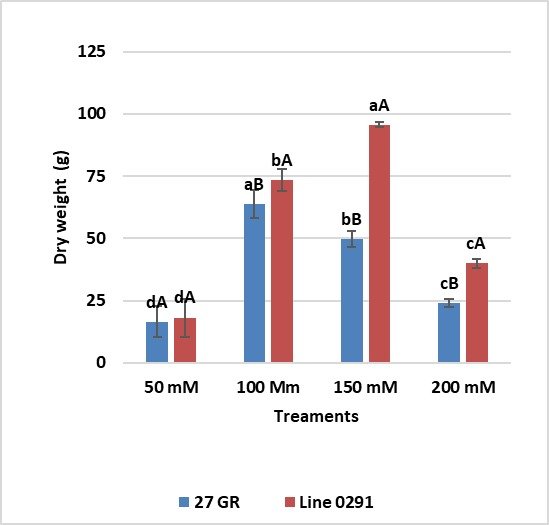Biochemical and Physiological Behavior Against Salt Stress Effect on Two Quinoa Accessions (Chenopodium Quinoa Willd.)
Keywords:
Chenopodium Quinoa Willd, Salt Stress, Osmolytes, Photosynthetic Parameters, Total Grain Yield.Abstract
Chenopodium quinoa Willd., is a halophyte plant, showing a great variability of response to salt stress. To better understand quinoa response to salinity, an open field experiment was carried out by subjecting two different origins quinoa accessions (27 GR and Line 0291) irrigated with different NaCl concentrations (50, 100, 150 and 200 mM). Photosythetic parameters (stomatic conductance and photosynthetic activity) biochemical parameters (proline, total sugars, total proteins), dry matter, water content and total grain yield were determined at fruiting stage. Results showed that increasing NaCl concentration induce a stimulation of dry matter and water content of different accessions, which can be explained by a well osmotic adjustment. İn addition, in 150 and 200mM of NaCl, proline synthesis in leaves was stimulated of 50% and 54% for 27 GR and of 29% and 87% for Line 0291 respectively. Similary, sugar content seemed to be stimulated by increased NaCl concentrations. However, salt stress induces for total protein content, a stimulatory action for Line 0291 of 70.6%, 69.8% and 14.4%, but an inhibitory one for 27 GR of 15.54%, 35.65% and 51.79% respectively under 100, 150 and 200mM treatments. Correlation analysis showed that proline contents were positively and significantly (P0.05) correlated with water contents in accession 27 GR leaves (r=0.761). While in Line 0291 accession, water content was significantly correlated with protein content (r=0.893) and dry matter (r=0.768). A significant decrease was noted for photosynthetic parameters and total grain yield which the most affected accession was 27 GR. İn fact, Line 0291 accession has the highest ability to absorb more water under stress compared to the control, this is due to its capacity to accumulate more osmolytes in their cells. Therefore, it has a more important photosynthetic activity. This accession has also the highest dry matter production and total grain yield.
Downloads

Published
How to Cite
Issue
Section
Copyright (c) 2022 Authors

This work is licensed under a Creative Commons Attribution-NonCommercial 4.0 International License.




